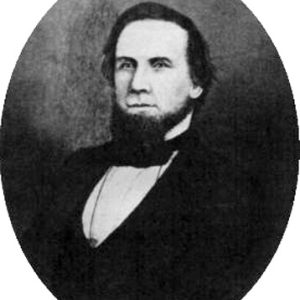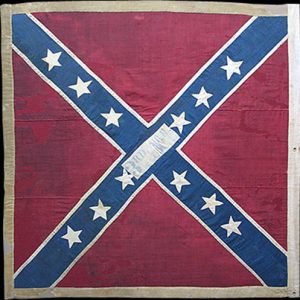calsfoundation@cals.org
Third Arkansas Volunteer Infantry Regiment (CS)
The Third Arkansas Volunteer Infantry Regiment originated from two companies that Hamburg (Ashley County) lawyer Van H. Manning and Dr. William H. Tebbs raised in Ashley County shortly after Arkansas seceded from the Union. The two companies traveled to Vicksburg, Mississippi, to join the Confederate army but were refused admittance. This led Manning to travel to Montgomery, Alabama, which was then the Confederate capital, to seek the aid of Senator Albert Rust of Arkansas. Rust not only helped the two orphan companies get into the army but also enlisted and returned to Arkansas to raise eight more companies and form a regiment.
Rust was successful in recruiting companies in Union, Drew, Ashley, and Hot Spring counties, and they traveled to Lynchburg, Virginia, where they and the original companies were mustered into Confederate service for three years, or the duration of the war, on July 5, 1861. (An eleventh company that was formed of men from Ashley and Drew counties joined the regiment later in 1861 as Company L.) The regiment elected Rust to lead them as their colonel, a position he held until his promotion to brigadier general on March 4, 1862, after which Manning succeeded him as colonel of the Third.
Rust led a force of the Third Arkansas joined with regiments of Virginia and Georgia troops against Union forces at Cheat Mountain, West Virginia, in early September 1861 but backed away from the Federal entrenchments without a fight. They fell back to the Greenbrier River, where Yankee troops attacked them on October 3; the Third distinguished itself in a fight that resulted in few casualties and a Federal retreat.
The Third Arkansas was transferred to Col. William Booth Taliaferro’s brigade in late November 1861 and moved to Staunton, Virginia, to join General Thomas J. “Stonewall” Jackson’s army. They drove a Union force from Bath, West Virginia, on January 4, 1862, and after occupying Romney, West Virginia, Jackson precipitated a near mutiny by ordering his troops to spend the winter there. The rebellious Confederates were distributed to other commands, with the Third Arkansas transferred to Virginia to serve under General Theophilus H. Holmes in John G. Walker’s brigade. The regiment took part but saw no action in the Seven Days Battles in June and early July, though it was bolstered by the addition of around 140 men of the Second Arkansas Infantry Battalion, which had suffered heavy casualties in the fighting around Richmond.
The Third Arkansas participated in the capture of Harper’s Ferry, West Virginia, on September 15 and then joined the Army of Northern Virginia’s invasion of Maryland. The regiment was heavily engaged in the fighting at Sharpsburg on September 17, helping to blunt a Union breakthrough but suffering twenty-seven dead and 155 wounded, including Manning. Companies A and L sustained such high casualties that they had to be consolidated following the army’s retreat to Virginia. On November 26, the Third Arkansas was transferred to join three Texas regiments in the Texas Brigade. They fought as part of that unit for the remainder of the war.
The regiment was present but not engaged in the fighting at Fredericksburg, Virginia, in December and then moved into the trenches defending the Confederate capital at Richmond. In June, they again moved north and saw intense action at Gettysburg. On the second day of the battle, July 2, the Texas Brigade was involved in the fighting at the Devil’s Den, and the Third Arkansas counted twenty-six men killed and 116 wounded.
The Third Arkansas was part of James Longstreet’s army that was hurried to support the Army of Tennessee in the fall of 1863 and took part in the fierce combat at Chickamauga, Georgia. On September 19, 1863, the first day of the battle, the Third was engaged for about an hour but, Manning reported, “had a number, remarkably large, killed and wounded during this time.” The regiment helped exploit a breakthrough in the Federal center the following day, which led the bulk of the Union army to flee to Chattanooga, Tennessee. The Third Arkansas again suffered heavily, losing twenty-five dead, 120 wounded, and twelve missing in the two days of fighting.
After wintering in Tennessee, the regiment returned to Virginia to face Ulysses S. Grant’s determined campaign against Richmond. After nearly three years of service, the regiment could muster fewer than 300 men. In the May 4–7, 1864, Battle of the Wilderness, the Third Arkansas lost Van Manning, who was severely wounded and captured, and suffered nearly sixty-five percent casualties, coming out of the confused fighting with fewer than 120 men present for duty. The regiment fought at Spotsylvania Courthouse, Cold Harbor, and Petersburg as Grant continued his inexorable push to capture the Confederate capital.
Richmond was abandoned in early April 1865, and Robert E. Lee surrendered the Army of Northern Virginia on April 9. Only 144 men remained of the 1,353 soldiers who had served in the Third Arkansas Infantry Regiment. The battle flag of the Third Arkansas is included in the collection of the Old State House Museum in Little Rock (Pulaski County).
For additional information:
Albritton, Orval E. “The Third Arkansas Regiment from Formation to Fredericksburg.” Arkansas Historical Quarterly 16 (Summer 1957): 150–162.
Bledsoe, Andrew Scott. “The Homecircle: Kinship and Community in the Third Arkansas Infantry, Texas Brigade, 1861–1865.” Arkansas Historical Quarterly 71 (Spring 2012): 22–43.
Collier, Calvin L. “They’ll Do to Tie To!” The Story of the Hood’s Arkansas Toothpicks. Little Rock: Butler Center Books, 2015.
Hawkins, Van. Duty Bound: The Hyatt Brothers and Confederates of the Third Arkansas Infantry Regiment, Army of Northern Virginia, C.S.A. Jonesboro: Arkansas State University, 2011.
Mark K. Christ
Little Rock, Arkansas
 Civil War Markers and Memorials (Outside Arkansas)
Civil War Markers and Memorials (Outside Arkansas) Civil War through Reconstruction, 1861 through 1874
Civil War through Reconstruction, 1861 through 1874 Military
Military Van H. Manning
Van H. Manning  Albert Rust
Albert Rust  Third Arkansas Battle Flag
Third Arkansas Battle Flag 




Comments
No comments on this entry yet.